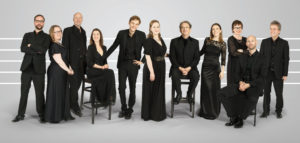Tallis Scholars Premiere Nico Muhly in Midtown

Tallis Scholars: A Renaissance Christmas
Miller Theatre Early Music Series
Church of St. Mary the Virgin
December 1, 2018
Published on Sequenza 21
By Christian Carey
NEW YORK – The Tallis Scholars, directed by Peter Phillips, made their annual appearance in New York as part of Miller Theatre’s Early Music series at the Church of St. Mary the Virgin in Midtown. The program was billed as a dual celebration — the 45th anniversary of the Tallis Scholars and Miller Theatre’s 30th anniversary season.
In honor of the occasion, Miller Theatre commissioned a new piece for the Tallis Scholars by composer Nico Muhly. Muhly has, of late, garnered a great deal of attention for two Metropolitan Opera commissions — Two Boys and Marnie — but he often talks about his first love being choral music (he began his musical career as a chorister). Muhly’s choral works are exquisitely crafted and texturally luminous. Rough Notes (2018), his new piece for the concert at St. Mary’s, took its texts from two diary entries by Robert Falcon Scott, written near the end of his ill-fated voyage to Antarctica. The first excerpt describes the aurora australis, providing words such as “arches, bands, and curtains” that are ripe for colorful musical setting. The second was Scott’s stoic expression of confidence in his team’s ability to accept their impending deaths with dignity. Muhly’s use of lush cluster chords in the first section gave way to more sharply etched, but still glinting, harmonies in the second, as well as poignantly arcing melodies. The divided choir of ten voices was skilfully overlapped to sound like many times that number. It is always fascinating to hear the Tallis Scholars switch centuries, and thus style, to perform contemporary repertoire; for instance, their CD of Arvo Pärt’s music is a treasure. One hopes that they might collaborate on a recording with Muhly in the future.
The rest of the program was of considerably earlier music, but ranged widely in chronology. The earliest piece was an elegant and under-heralded Magnificat setting by John Nesbett from the late Fifteenth century that is found in the Eton Choirbook. Chant passages give way to various fragments of the ensemble that pit low register vs. high for much of the piece. It culminates by finally bringing all the voices together in a rousing climax. The Tallis Scholars has, of yet, not recorded Nesbett, but Peter Phillips has committed the Magnificat to disc in an inspired performance with the Choir of Merton College, Oxford (The Marian Collection, Delphian, 2014).
Palestrina’s motet Hodie Christus natus est, and the eponymous parody mass which uses this as its source material, were the centerpiece of the concert. The motet was performed jubilantly and with abundant clarity. The mass is one of Palestrina’s finest. He took the natural zest of its source material, added plenty of contrapuntal elaborations, and made subtle shifts to supply a thoughtful rendition of the text. Although we are, in terms of the liturgical calendar, in the midst of the reflective period of Advent, being propelled forward to the midst of some of the most ebullient yet substantial Christmas music of the Renaissance was a welcome inauguration of the season.
The two works that concluded the concert dealt with different aspects of the Christmas story. William Byrd’s Lullaby is actually quite an unsettling piece; its text deals with the Slaughter of the Innocents as ordered by Herod. One is left to imagine the infant Jesus being consoled by Mary and Joseph in the midst of their flight from persecution. Byrd composed it in the Sixteenth century (it was published in 1588), but Lullaby was the piece on the concert most tailored to this moment, evoking concerns of our time: the plight of refugees, the slaughter of innocent bystanders by acts of senseless aggression: particularly the vulnerability of children to indiscriminate bombing abroad and the epidemic of gun violence in our own country.
The last piece returned to a festive spirit and brought the Tallis Scholars to the cusp of the Baroque with Hieronymus Praetorius’s Magnificat V with interpolations of two carols: Joseph lieber, Joseph mein and In dulci jubilo. During the Christmas season, interspersing carols and sections of the Magnificat was a standard practice in Baroque-era Lutheran churches; J.S. Bach might even have done so in the services he led at St. Thomas Church in Leipzig. Praetorius plus two carols gave the Tallis Scholars an opportunity to share three of their most-performed Christmas pieces. From seemingly effortless floating high notes to sonorous bass singing, with tons of deftly rendered imitative passages in the inner voices, the group made a glorious sound. One eagerly awaits their return to New York during their 46th season.